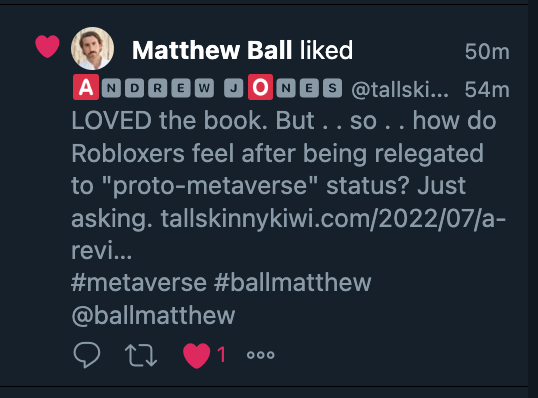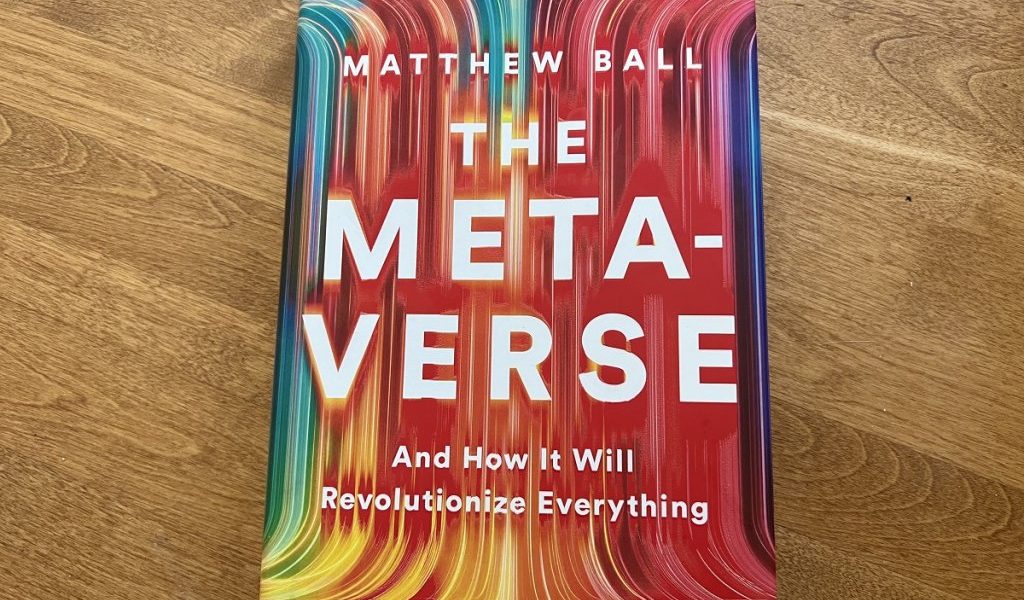I have long anticipated . . wait . . . let me switch to Aragorn . . . LONG have I anticipated this book [ahhh. . . thats better!] after reading Matthew Ball’s articles on the internet. It did not disappoint. Hype-free. Easy to read. And an amazing look into the metaverse and the powers behind it.
Matthew Ball’s intuition is informed, his predictions are feasible, his recommendations both warranted and necessary if the metaverse is to lean into its full potential.
Although acknowledging the technological advances made possible by the big players, he is not shy to throw stones at any of them when their polices impede the advancement of the metaverse.
I agree with with Ball that the metaverse as a concept will not be fully realized until the end of this decade and yet I also agree with Dr. Liew Voon Kiong (Metaverse made Easy) that the metaverse has been with us for more than a few decades. In the meantime, we will exist in the tension of being both now and not yet, and wondering if our achievements by 2030 will one day be seen by future generations as juvenile and clumsy.
Some might argue that Matthew Ball’s book on the metaverse is more about video games than the metaverse itself, which is probably true. But video gaming is the gateway to the metaverse, not just the computer processing power but the numbers behind economic incentives, the people behind the consoles, the often juvenile atmosphere, and such a focus needs no apology.
In fact the highlight of the book for me, apart from the interesting description of the Flight Simulator, was interaction with Neal Stevenson, author of the dystopian sci-fi novel “Snow Crash” which gave us the word ‘metaverse’. Stevenson said, although he envisioned what the metaverse looked like (I am not quoting from the book here) he did not know how it would happen and certainly did not expect video games to be the onramp.
I share Stevenson’s (and Ball’s) ironic surprise regarding the role of the video gaming industry in building the metaverse as we know it. It IS ironic. It is hilarious. It was unexpected and unforeseen.
Here is the definition everyone is talking about:
“Here, then, is what I mean when I write and speak about the Metaverse: “A massively scaled and interoperable network of real-time rendered 3D virtual worlds that can be experienced synchronously and persistently by an effectively unlimited number of users with an individual sense of presence, and with continuity of data, such as identity, history, entitlements, objects, communications, and payments.”
Matthew Ball. The Metaverse.
Although I find his definition a little long winded, and “effectively unlimited number of users” unnecessary, and perhaps the last string of words could be summed up in a tidy manner by just saying “digital assets”, it is widely generous enough to include 2D and (isometric) 2.5D under the 3D umbrella (where pixels will kiss voxels, or perhaps be transformed by them) and allow for non-blockchain and non-crypto solutions.
But for Ball, interoperability seems to be a prerequisite rather than a bonus, thus relegating Roblox further back on the shelf as a “proto-metaverse”, something Robloxers may find disappointing. (Second Lifers get it worse but I will leave it for them to respond to Matthew). I believe some metaverse environments will opt out of certain parts of interoperability. Owners of luxury mansions at Keys Metaverse, for example, will probably want to wear the swimwear they purchased at Fashion Week in Decentraland next to their virtual poolsides but will NOT want their back-yard socials interrupted by gun-wielding goons from Mobland and maybe the luxury of being un-interoperable will be like the privilege of living in a gated community. And China will probably never allow avatars in their metaverses to teleport to those in the West, at least not in my lifetime. BTW, Ball does discuss the metaverse situation in China and South Korea.
 [Thank you Matthew. HA!!!!!!!]
[Thank you Matthew. HA!!!!!!!]
But the book. Yes, its good and essential if you are in these industries or teach on the subject. Before you buy, have a bo peep at his recent article on Time.
I would have expected to see Habbo mentioned at least once. It was where my kids first built their rooms as avatars, before they moved on to build igloos in Club Penguin (now deceased), which also lacks a mention in the book, where preference is given to the current dominant games such as Minecraft, Fortnite and Roblox.
But maybe its a good thing Habbo was not mentioned in Ball’s book, where it may have been assigned a lower ranking as a “proto-metaverse”. Because now we can continue to call it a metaverse, even if all the pieces are not fully there yet.
Oh . .. and if you are looking for a review better than mine on Matthew Ball’s Metaverse book, I have read a few of them. The review on Forbes is gushing with adolescent praise but I believe the best one, which is actually a piece of textual and conceptual art in its own right, is Dusting Off Our Mirror-Shades: On Matthew Ball’s “The Metaverse”. And Tom, yours is good too!
Thank you for reading all the way down. If you are in England next month, hear me speak at Greenbelt Festival on church in the metaverse.



